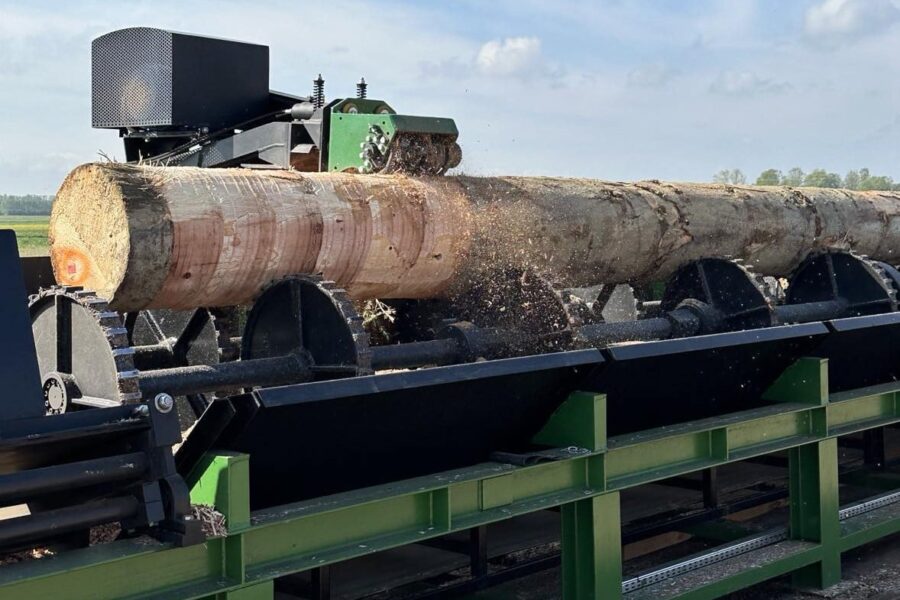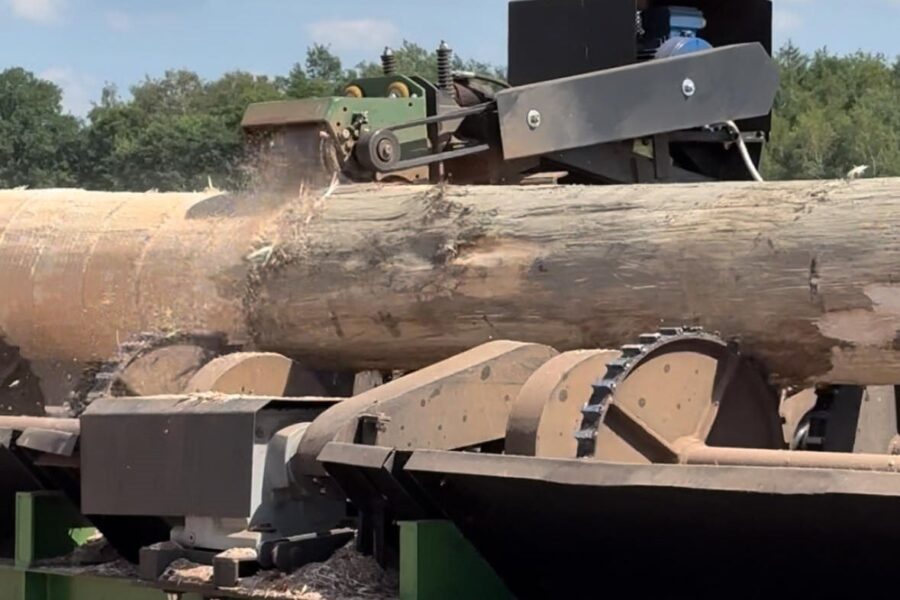





We invite you to familiarize yourself with our offer of sawmill machines
The debarker is a machine designed to remove bark from both coniferous (softwood) and deciduous (hardwood) tree logs. The type of milling debarker in our offer makes it possible to remove bark from fir, spruce or pine, as well as from hardwood, including oak or beech logs.
The offer for our debarker is addressed to entrepreneurs with long-term business vision. We would like our debarkers to provide trouble-free service for years and this cannot be achieved by using low-quality components.
Our debarker machines are made to order. It means that we customise them to the needs of our customers’ business and they vary considerably, depending on the application – some entrepreneurs need a milling debarker for logs up to 12 metres long, while other customers need them for shorter logs, up to 4 metres, but for higher diameter, even up to 100 cm. The same applies to feeders – customers look both for comprehensive solutions with a complete feeding system and conveyors, as well as only a debarker machine. However, shortage of skilled workers forces many companies to invest in automated production lines, which additionally enhances the effect of higher performance. By using our experience, we advise and take care of optimum use of internal plant logistics to adjust the machine park to the existing infrastructure.
The most commonly constructed 3 types of debarker machines include:
In this particular model, the debarking head moves along the roller conveyor. The operator controls the feed speed, as well as the log speed or rotation by setting the speed of gears.
In this version the debarking line is installed in one place, while the log moves with the whole roller conveyor. A solution recommended in special situations, for example, when we wish to discharge the debarked log in the same direction as the direction of loading.
Below, we present an example of debarking line arrangement
Example of debarker machine technical parameters:
Main debarker machine motor 18.5 kW
Total installed power 45 kW
Log diameter 20 – 90 cm
Log length 2 – 14 m
What is important, we offer our own dedicated debarking blades, for the quality of which we take full responsibility. The experience of our customers shows, that they are durable, while the price per set is lower by over a half than for the ones offered by our competitors. Considering the long-term use of debarking machines, this aspect is also worth analysing before making the final purchase decision.
Refer to the FAQ (Frequently Asked Questions) section below for more information.
This is one of the most frequently asked questions. There are many times when customers would like to collect a machine within a short time, however, we cannot meet this requirement due to a large number of orders. All depends on the current production capacity that changes over time. However, we can assume that an average lead time is about 3 months. However, sometimes it happens that we can execute an order earlier, say within a month, but sometimes the lead time can extend to 6 months. The lead time is provided in the contract to ensure customers that the machine will be ready for collection as per arranged and accepted schedule.
Yes, it is possible to reduce root inflows. However, in the case when you plan to debark logs with significant butt-end, installing additional butt-end reducer is worth considering.
The output of the debarking line in cubic metres depends on many parameters, i.e. log length and curvature, operator skills, method for loading logs and the system of feeders/conveyors. However, we usually assume that during one shift (8 hours) it is possible to debark 60 cubic metres, but this is not always the case. For example, one of our customers who debarks 4 metre long pine logs achieves the output of approximately 120 cubic metres per shift.
Any log contamination is removed with bark, which allows us to save tools at further stages of woodworking process. Therefore, in long term operation, the debarker helps reduce the costs of woodworking and the downtime needed to replace the saw blades. For instance, before installing a debarker in one of our customer’s plants, it was necessary to replace saw blades six times a day, while after installing a JUWAL debarker the saw blades are replaced only once a day.
We can make a debarker machine to process log diameters ranging from 150 mm up to even 1300 mm, but everything depends on individual plant needs. For more detailed information on the range of logs to be debarked, do not hesitate to contact us.
There are at least a few alternatives available, as the bark can be a source of additional profits. There are many customers who sell the bark and the money obtained is allocated to cover the cost of machinery leasing or use it “in house” as fuel.
Our customers are located all around Poland, but also abroad, e.g in Ukraine or Romania. If you wish to see our debarking line operating in a customer’s plant – please contact us and we will provide you with information about the production plant closest to your location, where you can see our debarker during operation.
Yes, but it involves additional costs, therefore not all customers decide to choose this option. However, we deliver a full set of information and documentation describing how to prepare the foundations to install the debarking line. Before concluding a contract, we arrange all details that include installation matters.
We would like our milling debarkers to be operated as per the intended use, therefore trainings for operating personnel are mandatory. It makes it possible to improve the safety level, and additionally helps extend the debarker life and avoid failures.
Yes! We are confident about the quality of our debarker machines, therefore we grant warranties and provide a warranty and post-warranty service. If you are interested in the extended warranty option – just let us know, and we will provide you with our offer.
Yes. We cooperate with a few leasing service providers, therefore, if you are interested in this payment method – please let us know, and we will provide you with contact details to persons who will handle the problem.
Yes! We deal with upgrading and refurbishing old debarking machines. Sometimes a replacement of debarking head will do.
There is always a way out. It is not always necessary to replace the whole debarking line. We will be pleased to assist you with your problem to present a cost-effective solution.
Below, we present a gallery of our projects. We encourage you to check out the photos, videos from our projects and contact us. We will be pleased to answer all your questions.